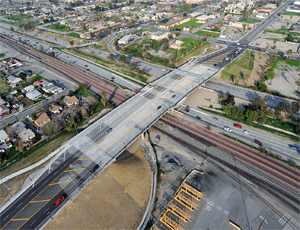Between nearly $50 billion in federal stimulus money and massive bond programs moving ahead in several states, funding for the transportation sector has been flying high this year. But the realities of the recession, coupled with heated debate over future funding streams, could bring the market back to earth in the coming years.


Transportation was given high priority in the American Recovery and Reinvestment Act, which devoted $49.3 billion to the sector out of nearly $140 billion in total construction dollars. The Obama administration’s intention was to get work started soon after the bill was signed in February, but much of the funding will continue to flow in 2010. Under ARRA, states were required to designate half of their highway and bridge funding by June 30 and the remaining half by March 2010. The General Accounting Office estimates that $18 billion of $27.5 billion for highways and bridges had been obligated by Sept. 1.
Robert Murray, vice president of economic affairs at McGraw-Hill Construction, of which ENR is a unit, says transportation is among the few sectors “guaranteed for growth in 2010.” After seeing spending on new starts in highway and bridge projects rise from $52.9 billion in 2008 to $57.3 billion in 2009, Murray estimates spending could reach $64.7 billion in 2010, a whopping 13% increase.
The stimulus transportation spike belies the financial realities of many states. Revenues have eroded during the recession, as many states rely on fuel taxes and fees on items such as car sales and vehicle registration, all of which have dipped nationwide. Although states have been moving forward on long-range capital plans, many are starting to trim them back. Fifteen states cut their programs in 2009, and another 19 expect cuts in 2010, according to the American Road & Transportation Builders Association (ARTBA), Washington, D.C.
Even more worrisome for state departments of transportation is the fate of the next highway authorization bill. Serious debate over the successor for the Safe, Accountable, Flexible, Efficient Transportation Equity Act (SAFETEA-LU) has been tabled as Congress addresses other priorities such as health-care reform and cap-and-trade programs to control air emissions, says Jeff Solsby, ARTBA public affairs director. “We’re headed for a funding cliff at the end of 2010, and it has yet to be determined how we deal with that when there’s no authorization bill,” he says.
Without a bill, the situation could be similar to 2002 and 2003 when the nation was also pulling out of an economic slump and funding was kept moving through extensions rather than long-term authorization legislation. Says Solsby, “Back then, we saw states put off long-term decisions because they didn’t have clear direction from the federal government. If we don’t get a bill, that could happen again.”
In recent months, federal highway funding has been on life support. In August, Congress approved an infusion of an additional $7 billion into the highway trust fund, the second such measure in less than a year. The House Transportation and Infrastructure Committee began discussion of a reauthorization bill over the summer, with Chairman James Oberstar (D-Minn.) pushing a six-year, $500-billion plan, nearly double the current level of funding. However, the bill has failed to make significant progress. Funding was to expire on Sept. 30, but Congress resorted to a one-month continuing resolution to keep money moving. On Oct. 29, Congress approved another stop-gap measure to extend funding through Dec. 18.
For many state DOTs, short-term stopgap measures make long-term planning nearly impossible. Following the 30-day stopgap passed by Congress in September, Oklahoma put new lettings on hold. Oklahoma DOT Director Gary Ridley says the state couldn’t effectively plan without a long-term bill in place. As a result, $53 million worth of projects scheduled to be bid in November were put on hold.
“We have bond payments due at the start of the fiscal year and those payments have to come off the top,” Ridley says. “We’re holding off on any projects that weren’t stimulus or done entirely with state fund. Normally, we don’t have a December letting, so it could be January before we have another one depending on what Congress does.”
Susan Martinovich, Nevada DOT director, says her department is forced to take a similar approach. In September, the state decided to pull back on major new awards until the federal picture becomes clearer. “We’ve got a big project that we’re holding because I can’t put my state in jeopardy of carrying the loan if we can’t be sure we’ll be reimbursed,” she says. “All we can do is get projects in the queue, but not release them until we get a better idea of where things are headed.”
Both Martinovich and Ridley speculate that a new transportation bill is unlikely in the near future. Given the level of increase in the Oberstar proposal, they expect extensive debate over how to fund a program that is already...


Post a comment to this article
Report Abusive Comment